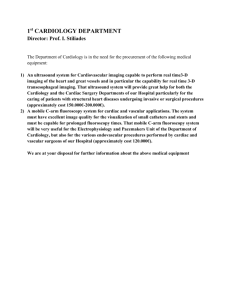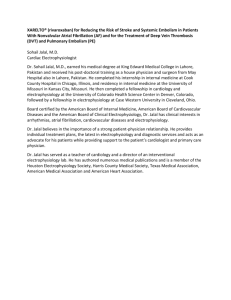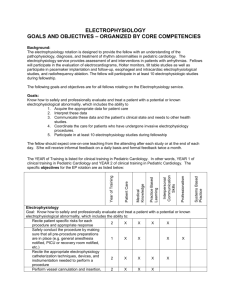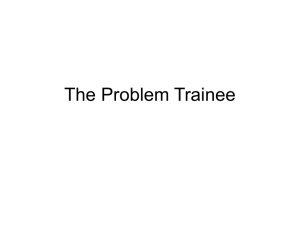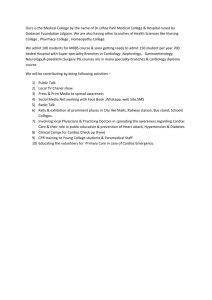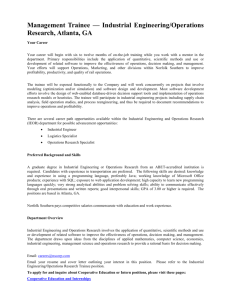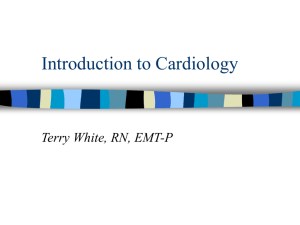ELECTROPHSYIOLOGY TRAINING IN THE CORE CARDIOLOGY
advertisement
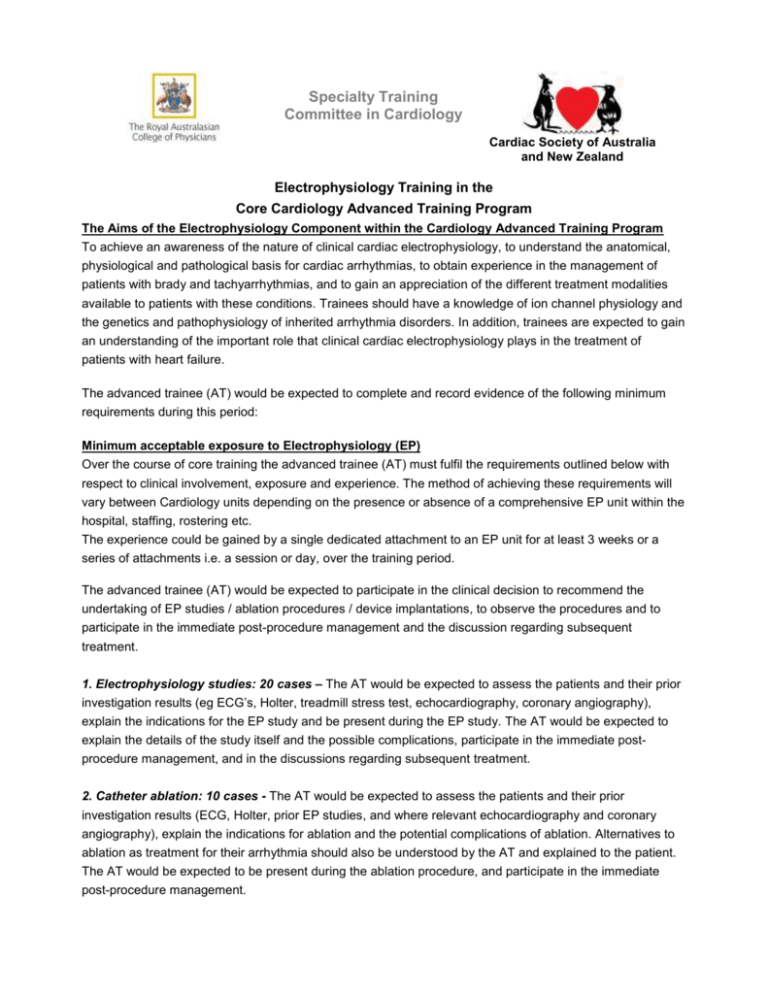
Specialty Training Committee in Cardiology Cardiac Society of Australia and New Zealand Electrophysiology Training in the Core Cardiology Advanced Training Program The Aims of the Electrophysiology Component within the Cardiology Advanced Training Program To achieve an awareness of the nature of clinical cardiac electrophysiology, to understand the anatomical, physiological and pathological basis for cardiac arrhythmias, to obtain experience in the management of patients with brady and tachyarrhythmias, and to gain an appreciation of the different treatment modalities available to patients with these conditions. Trainees should have a knowledge of ion channel physiology and the genetics and pathophysiology of inherited arrhythmia disorders. In addition, trainees are expected to gain an understanding of the important role that clinical cardiac electrophysiology plays in the treatment of patients with heart failure. The advanced trainee (AT) would be expected to complete and record evidence of the following minimum requirements during this period: Minimum acceptable exposure to Electrophysiology (EP) Over the course of core training the advanced trainee (AT) must fulfil the requirements outlined below with respect to clinical involvement, exposure and experience. The method of achieving these requirements will vary between Cardiology units depending on the presence or absence of a comprehensive EP unit within the hospital, staffing, rostering etc. The experience could be gained by a single dedicated attachment to an EP unit for at least 3 weeks or a series of attachments i.e. a session or day, over the training period. The advanced trainee (AT) would be expected to participate in the clinical decision to recommend the undertaking of EP studies / ablation procedures / device implantations, to observe the procedures and to participate in the immediate post-procedure management and the discussion regarding subsequent treatment. 1. Electrophysiology studies: 20 cases – The AT would be expected to assess the patients and their prior investigation results (eg ECG’s, Holter, treadmill stress test, echocardiography, coronary angiography), explain the indications for the EP study and be present during the EP study. The AT would be expected to explain the details of the study itself and the possible complications, participate in the immediate postprocedure management, and in the discussions regarding subsequent treatment. 2. Catheter ablation: 10 cases - The AT would be expected to assess the patients and their prior investigation results (ECG, Holter, prior EP studies, and where relevant echocardiography and coronary angiography), explain the indications for ablation and the potential complications of ablation. Alternatives to ablation as treatment for their arrhythmia should also be understood by the AT and explained to the patient. The AT would be expected to be present during the ablation procedure, and participate in the immediate post-procedure management. 3.1 Pacemaker implantation: 10 cases - The AT would be expected to, assess the patients and their prior investigation results (ECG, Holter, prior EP studies), explain the indications for pacing, have an understanding of the possible procedural and long term complications of pacemaker implantation, be present during the pacemaker implantation, and participate in the immediate post-implantation management. Ideally the trainee should be present at the insertion of both single chamber and dual chamber pacemakers. 3.2 ICD implantation: 3 cases - The AT would be expected to be involved in the assessment of the patients and their suitability for ICD implantation, have an understanding of the possible procedural and long term complications of ICD implantation, have a basic understanding of the programming of the ICD and be involved in post-procedure care. 3.3 Cardiac resynchronisation devices: 3 cases - The AT should be involved in the assessment of patients for consideration of cardiac resynchronisation therapy (CRT). The trainee should understand the indications for CRT and the principles underlying this mode of treatment for patients with congestive cardiac failure. The AT would be expected to be present at the implantation of the device and have an understanding of the technical issues both during and after implantation. The AT should also have an understanding of the principles of optimisation of CRT settings. 4. Operational skills for temporary pacing wire insertion: The AT will be expected to acquire the operational skills to perform right heart catheterisation via the femoral vein; these skills could be acquired through direct participation in EP studies. The AT will be expected to have the necessary knowledge to manage a temporary pacing wire post insertion. 5. Attend pacemaker clinic – Review a minimum of 20 patients and demonstrate an understanding of the pacemaker programming modes, how to recognise and troubleshoot pacemaker dysfunction, and appreciate the principles of resynchronisation therapy. Note that these cases may be included in the 100 pacemaker reviews needed to meet log book requirements. 6. Ward rounds – The AT would be required to participate in the daily review of patients admitted for investigation and management of arrhythmias, along with patients found to have significant arrhythmias complicating their admission. 7. Brief case presentation: 2 cases will be presented to a working meeting of the cardiology unit. Each case should include discussion of both acute and long-term arrhythmia management strategies. 8. Supervisor assessment – The AT should be given formal feedback from a cardiologist qualified in clinical electrophysiology. 9. Documentation: The details of the patients assessed in items 1, 2, 3, and 5, and the cases presented in item 7 should be documented in the AT’s log book. A statement indicating satisfactory attendance and performance during the EP rotation should be signed by a supervising cardiologist qualified in clinical electrophysiology. Specialty Training Committee in Cardiology Cardiac Society of Australia and New Zealand ELECTROPHYSIOLOGY (EP) TRAINING SUPERVISOR’S REPORT Adult Medicine Division TRAINEE DETAILS AND TRAINING POSITION Full Name of Trainee Report covers period From To Date (dd/mm/yy) Date (dd/mm/yy) Training position Year of advanced training EP SUPERVISOR DETAILS Full Name of Supervisor Qualifications Department Hospital Phone (W) E-mail CLINICAL SUPERVISOR DETAILS As nominated on your annual application Full Name of Supervisor Department Hospital Fax (W) EP SUPERVISOR’S COMMENTS I have discussed this assessment with the Trainee and make the following comments: or I have not discussed this assessment with the Trainee for the following reasons: Electrophysiology Training Supervisor's Signature Date (dd/mm/yy) CLINICAL SUPERVISOR I verify this component of training is complete Clinical Supervisor's Signature Date (dd/mm/yy) FURTHER INFORMATION Enquiries Education Officer Phone: 64 4 472 6713 Fax: 64 4 472 6718 Email: Cardiology@racp.org.nz Please send report to: Education Services The Royal Australasian College of Physicians 99 The Terrace Wellington NEW ZEALAND
